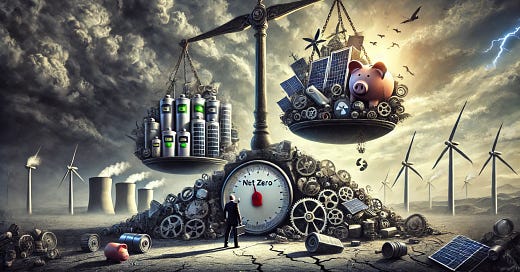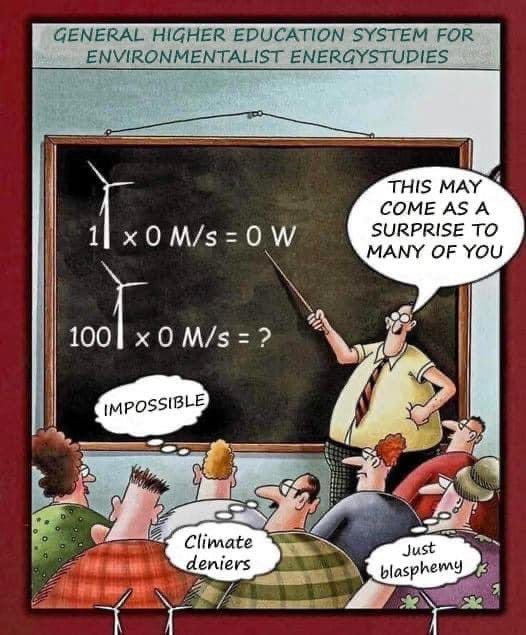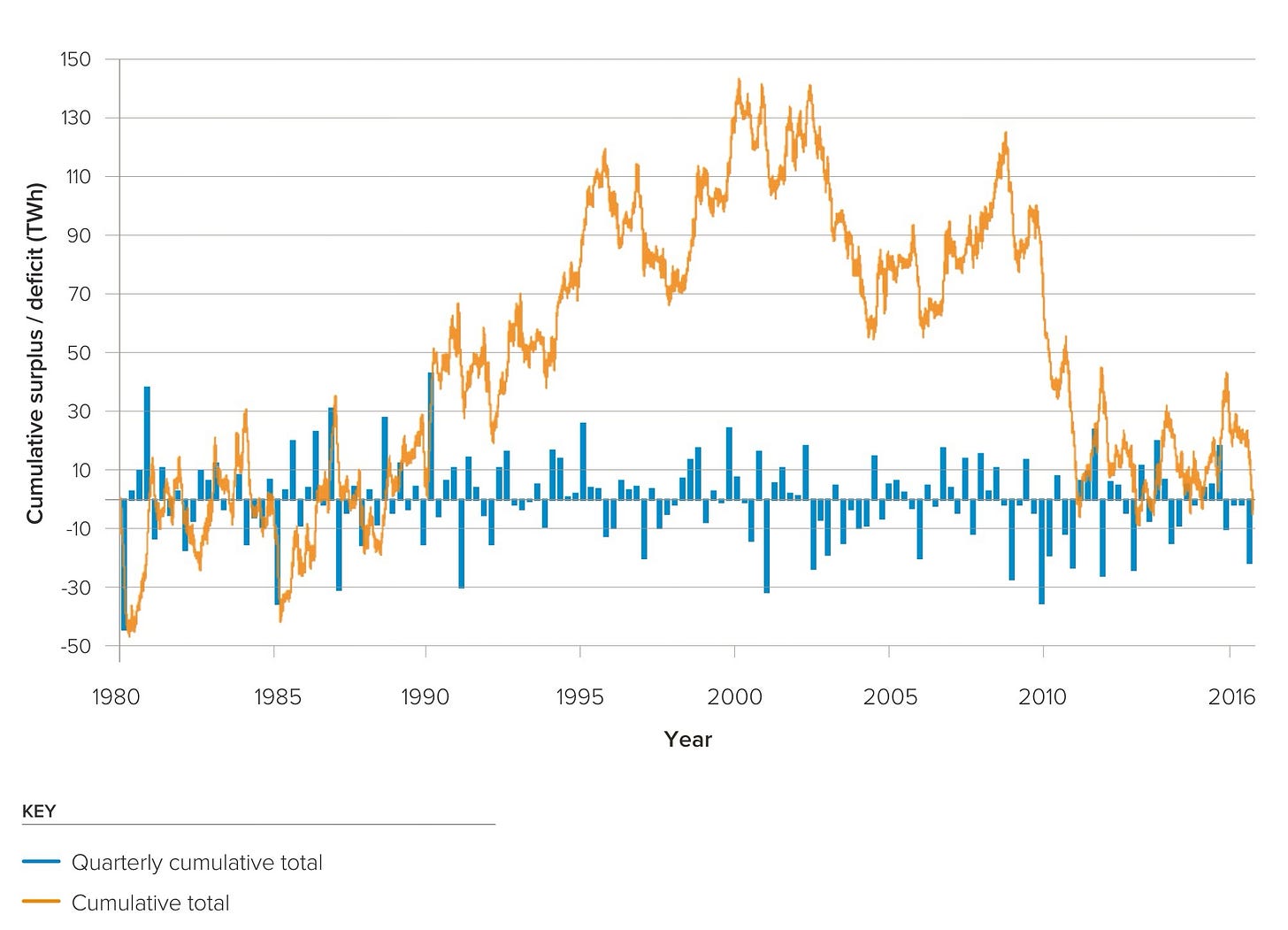UK renewables' trillion pound energy storage problem.
Mitigating UK solar and wind's catastrophic intermittency problem requires unproven storage solutions of almost unimaginable costs.
THIS WEEK, THE oxymoronically titled Secretary of State for Energy Security and Net Zero announced that he is lowering household energy bills. He’s doing this by locking us for 15 years into a 58% increase in the price that wind generators are guaranteed for their unreliable product, effectively increasing the subsidy we pay them through our energy bills by another £9 billion.1 This is in service, you’ll recall, of his intention to double onshore wind intermittent power generation, triple solar intermittent power generation, and quadruple offshore intermittent power generation in order to avoid a 0.0 degC increase in global temperature.2
“Shit’s gettin’ real!”, as a Climate Industrial Complex lobbyist might say.
They say that, when going broke, nothing seems to happen for a long time, then everything happens at once. Something similar is happening here. In a government of individuals of astonishing intellectual shallowness and technical illiteracy, Miliband adds another characteristic: he believes this nonsense. He’s Rasputin. Unless he’s stopped—and there’s no evidence of Starmer’s willingness or ability to do so—he’s going to run his suicidal deindustrialisation program to failure at breakneck speed.
So as we accelerate towards insolvency, it might be wise to start paying even closer attention to how much it’s going to hurt. In this week’s essay, we take a look at unreliable energy sources’ second biggest technical problem: storage.3
WITH VIABLE FUEL sources, such as nuclear or hydrocarbon, energy is stored in the atoms and chemical bonds of stocks of the fuel. This has a practical advantage: when you take your child to Accident and Emergency with appendicitis, a fuel valve is automatically opened up somewhere and the energy to treat her is instantly delivered.
In a toy system based on scavenging energy from occasional gusts of wind and rays of sunshine, you either have to invite your child to wait until the wind is blowing before she develops appendicitis, or proactively have her healthy one removed on a windy day. The third option is the one we were forced to accept in Victorian times, when net energy levels were at “Net Zero” levels and child mortality was an order of magnitude higher.
Since none of these are politically acceptable, some system has to be devised for dealing with the problem of unreliability. Right now, when the wind stops, we ramp up gas-fired power stations.4 The wind industry’s attitude to the oil and gas industry is rather like the attitude of a sulky live-at-home teenager, who emerges at dinner to be fed and spends the rest of the time in the basement imagining his lifestyle to be entirely sustainable while having no idea what his parents do every day to provide his food, shelter, and warmth.
But say we were to capitulate to “Just Stop Oil” teenagers, and just stop oil. How would the energy system work then, on paper at least?
ONE OPTION MIGHT be to install excess generating capacity. If a system produces only 20% of our requirement on an average windy day, then they might build five times more capacity and throw the excess away on very windy days.
Unfortunately, even if the extravagant cost could be accommodated, that doesn’t work because the wind often doesn’t blow and the sun often doesn’t shine at all. And because, when that happens, it often happens over the whole of Europe, imports cannot be relied upon—chances are, the wind isn’t blowing there either. Naturally, Miliband plans to spend vast sums on wires to connect us to those other windless regions.
So an ‘unreliables’ energy system with no hydrocarbon or nuclear backup is forced to employ some sort of storage. Generation that is excess to demand (say, on a windy night when everyone is in bed) is stored somewhere, and produced back when the wind has stopped. Sounds simple. The quadrillion dollar question is: how much storage is needed?
There are two answer to this: the naïve one that informs current UK energy policy: “a few hours of national demand”; and the one that is arrived at from an engineering study of decadal demand and wind and solar patterns: “a very, very large amount”. Let’s look briefly at an example of the latter.
THE ROYAL SOCIETY, known officially as The Royal Society of London for Improving Natural Knowledge, is one of the world’s most prestigious scientific institutions. Founded in 1660, it is a fellowship of many of the world’s most eminent scientists and is dedicated to promoting excellence in science for the benefit of humanity.
Last year, it issued a report quantifying the storage that a fully electrified UK economy would need to avoid catastrophic blackouts.5 I won’t go into the details here—while the report is technical, the management summary is perfectly digestible for a general reader. But a short summary is in order.
To estimate storage, they compare the cumulative difference on an hourly basis between demand and supply, using three decades of historical wind and solar generation data and hypothetical demand data that scales typical annual demand variation by the amount needed for an electrified economy.
At each moment, any generation in excess of demand is diverted to some form of storage; any demand in excess of generation is supplied from that storage. The total quantity of storage is the amount that is needed to prevent unmet demand in the worst case series of demand-higher-than-supply hours.
The analysis is horrifying.
Naïve analysis—Mr Miliband’s—fails to recognise inter-year variation in wind generation. Our weather varies at different scales, most noticeably annually between winter and summer. But it is also driven by the North Atlantic Oscillation, which affects European weather patterns over decades. Even in the thirty seven years of weather data analysed, we observe periods of 3 or 4 consecutive years of wind drought. This is unlikely to be worst case.
The implications of this for storing unreliable energy are devastating. Far from having to store a couple of hours of national electricity demand for a day or two—itself, an unprecedented engineering challenge that has never been achieved anywhere—UK would have to store months of total demand for years to survive multi-year wind droughts.
In the demand scenario investigated, that’s 180 Terra-watt Hours of energy—about 10 Hiroshima nuclear bombs. There is no battery technology—now, or in prospect—that can store that quantity of energy for that duration. There is no battery solution to the Net Zero storage predicament.
All of the alternative “solutions” investigated in the report are unaffordable, and commercially unavailable. The one they identify as the least unworkable is conversion of excess generation into hydrogen, which they propose injecting into the ground in places like East Yorkshire and Cheshire. That in itself is amusing, as converting energy into hydrogen and back to electricity involves throwing half of it away. Which means, all other things being equal, we’d have to double the capacity (and cost) of our energy generation capacity—one for us, and one for the losses in the storage system. Equally amusing is the mental flexibility required to ban gas fracturing operations over concerns about the minor tremors that they occasionally produce, while proposing injecting nuclear weapon quantities of energy into caverns under people’s feet.
All of this is unimaginably expensive. Even the error in the report—it assumes final costs for technologies at the start of a notional project that don’t currently exist and are assumed to get invented and less expensive with time—is around half a trillion pounds. Adding that back in propels costs to a trillion pounds.
That assumes energy demand that is significantly lower than other demand scenarios. Actual costs will be significantly higher. Results in other countries are comparable—energy storage costs in the US for a fully electrified economy are estimated in the region of $220 trillion to $2.2 quadrillion.6
And remember—none of this produces anything of value beside an unmeasurable change in an imaginary malfunction in the weather. It’s pure additional cost that merely gets us back to the reliability we already enjoy with a gas and nuclear system.
Our bovine elected representatives signed into force the environmental legislation motivating all of this without even a debate, much less a vote. Having restated his determination to force it down our throats, technically illiterate and clueless Mr Miliband wrote this week to the Transmission network’s boss for ideas on how to do it. His reply will be interesting.
It is impossible to overstate the scale of how utterly ill-conceived and reckless all of this is.
We must say “No to Net Zero”.
Homewood, P. (2024) ‘£9 Billion Subsidy Bill For Latest Round Of CfDs’, NOT A LOT OF PEOPLE KNOW THAT, 5 September. Available at: https://notalotofpeopleknowthat.wordpress.com/2024/09/05/9-billion-subsidy-bill-for-latest-round-of-cfds/ (Accessed: 6 September 2024).
Lindzen, R., Happer, W. and van Wijngaarden, W.A. (2024) ‘Net Zero Averted Temperature Increase’.
Unreliable energy sources’ biggest technical problem is that you can’t actually run an advanced industrial economy on them. See: Lyon, R. (2024) The physics of Net Zero. Available at: https://richardlyon.substack.com/p/the-physics-of-net-zero
We also use a quantity of so-called “biofuels” which, being in short supply, environmentally disastrous, and ruinously expensive, cannot be scaled up adequately to replace gas.
Llewellyn Smith, C. (2023) Large-scale electricity storage. The Royal Society. Available at: https://royalsociety.org/news-resources/projects/low-carbon-energy-programme/large-scale-electricity-storage/ (Accessed: 4 September 2024).
Reid, E. (2024) ‘All-Electric Storage’, 30 April. Available at: https://www.therightinsight.org/All-Electric-Storage.







Some of us have been pointing out the infeasibility of Net Zero and its 80% Climate Change Act predecessor for more than two decades. Hardly any politicians and precious few of the general public ever took any heed. I was often told I was a crank for my troubles (here in 2015): https://euanmearns.com/time-for-the-tories-to-repeal-the-2008-climate-change-act/.
Some blame this situation on “groupthink” but I think it is a problem of lack of critical thinking. We have got to the stage where most scientists, most of the MSM and most of our Uniparty (Lab/Con/Lib/SNP) politicians toe the “climate change” party line laid down by unaccountable globalist bodies like the Club of Rome (“The real enemy, then, is humanity itself”), the United Nations (“global boiling”, “oceans overflowing”), the COP pantomimes, Big Money influencers and the Paris Agreement (and Kyoto before it) meekly accept that we must stop using fossil fuels and instead use short-lifespan, toxically non-recyclable, impossibly expensive to construct and integrate, heavily resource-depleting, inefficient, unreliable, weather-dependent so-called renewables.
They disregard the proper science that tells us that atmospheric CO2 is not a threat because its global warming effect is already “saturated”, meaning that even a far-distant doubling of its concentration from the present level will have negligible effect on the climate. They also ignore the fact that unilateral decarbonisation by the UK is doubly pointless given that the majority non-Western world is not following suit.
They apparently never stop to think that Net Zero is totally infeasible technically and is certain to lead to mass destitution and depopulation, which seems to be the ulterior motive of the globalists who are calling the shots. If any of them do harbour any doubts, they never voice them publicly.
This is a problem of submission to centralised control and authoritarian brainwashing on an unlimited budget, leading the people in a terribly bad direction. It was the same with the Covid so-called plandemic led by the unaccountable WHO (a subsidiary of the United Nations) and Big Money.
President Trump did the right thing in taking the USA out of the WHO, only for Biden to join up again. If Trump survives to take office again, he will hopefully succeed in taking on and defeating the evil supranational forces which are, by one means or another, intent on leading us to ruination.
My latest debunking of the climate change hoax is here: https://metatron.substack.com/p/debunking-the-climate-change-hoax.
It was strange that the Tories didn't make Milliband, the eco militant, more of a 'bogeyman' during the election campaign. A man who can stand in front of an 'Edstone' with pledges on it (during another election campaign) is clearly a battery with no volts.
The storage 'problem' is our problem not his - he doesn't live in the areas where unstable materials will be deposited.
Didn't the Climate Change Committee in 2008 base their analysis of wind production for the future on 1 year's 'supply' of wind? He paints the scenario of not being dependent on the energy of mad dictators on the Continent but says nothing about himself.